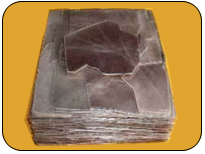|
| |
 |
|
| |
| |
 Mica
ore coming out of mines are in crude form contaminated with
various foreign materials; hence for commercial purposes it
is processed and 0000000classified in different forms on the
basis of Size, Thickness and Quality as follows: Mica
ore coming out of mines are in crude form contaminated with
various foreign materials; hence for commercial purposes it
is processed and 0000000classified in different forms on the
basis of Size, Thickness and Quality as follows:
The
standard grading system for all full-trimmed muscovite mica
is based on the minimum usable rectangle (usable area) that
may be cut from the specimen. |
Mica
Blocks :-
 Knife
dressed sheet mica of a minimum thickness of 0.18 mm (0.007
Inch), is called Block mica and of thickness between 0.05 up
to 0.18 mm (0.007 to 0.030 Inch), is called thin mica. They
are available both in random and calibrated thickness as per
requirement. Knife
dressed sheet mica of a minimum thickness of 0.18 mm (0.007
Inch), is called Block mica and of thickness between 0.05 up
to 0.18 mm (0.007 to 0.030 Inch), is called thin mica. They
are available both in random and calibrated thickness as per
requirement.
|
Mica
Films :-
Scissor
dressed sheet mica split from superior quality block mica to
required range of thickness between 0.2 up to 0.18 mm (O.0008
up to O.007 Inch) is called Mica Film.
Precisely
calibrated thickness, clean cut edges without fraying or splitting,
flawlessness and free from stains, spots, dots, impurities,
cracks, buckles, pinholes, etc. are some of the essential points
observed in the manufacture of film mica. |
Mica Splittings
:-
Laminae
split from inferior quality Mica Blocks, in thickness of ten
sheets, of which taken together does not exceed 0.30 mm (0.012
Inch), is called splitting mica. Splitting mica chiefly used
in the manufacture of built-up mica or Micanite products as
raw materiel for ultimate use as an Insulating material. |
|
Mica Scrap :-
Scrap
mica obtained in course of Cobbing, rifting and dressing crude
mica as extracted from the mine, by means of a sickle, as well
as, recovered by means of hammer-crushing cross-grained mica,
which cannot be used as sheet mica for commercial purposes,
is classified as Mica Scrap. |
| Mica Flakes
& Powder :-
Grinding
of Mica Scrap properly cleaned by removing all types of foreign
particles produces Mica Flakes & Powder. They are further
screened or classified to various granulation sizes. They are
Micatech Corporation and inert to most of the chemicals and thermal conditions
while retaining elasticity and slipperiness far superior to
conventional ground minerals or rocks |
|
|
| |
|
 |
| |
|
|